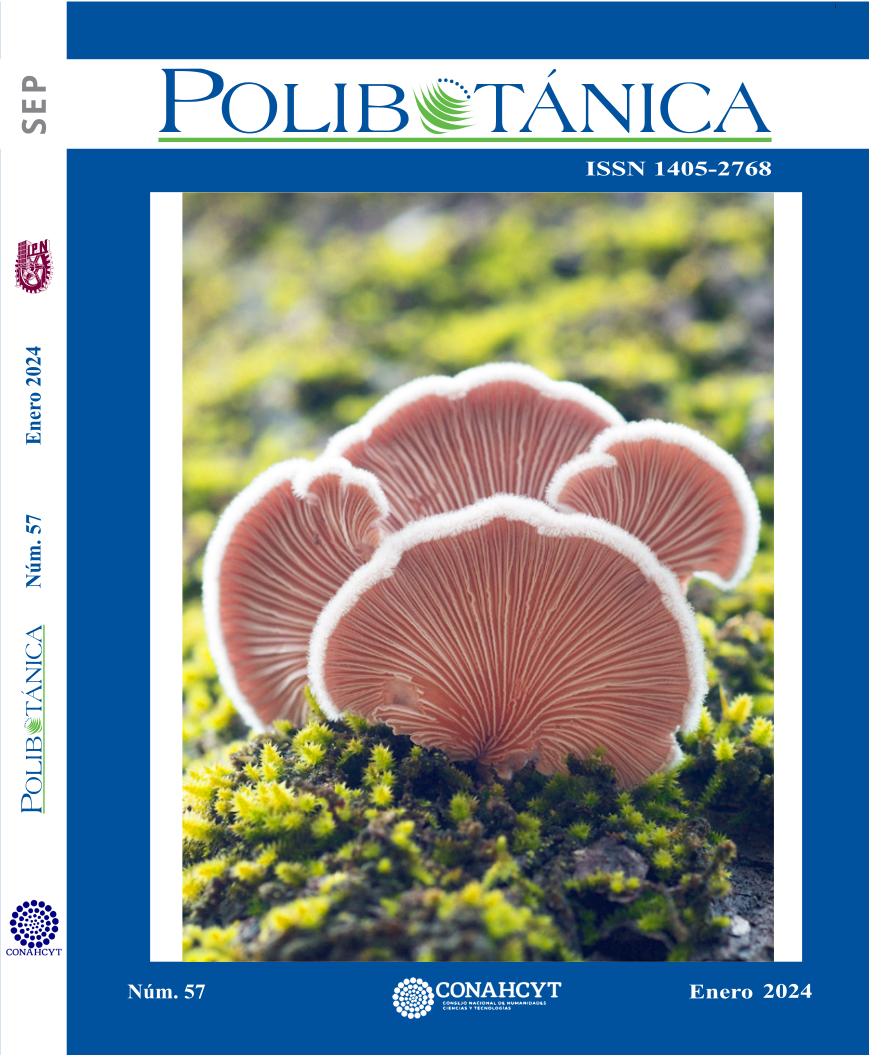Edible Begonias from Santiago Ecatlán, municipality of Jonotla, Puebla, México
DOI:
https://doi.org/10.18387/polibotanica.57.15Keywords:
Begonia, Ecatlán, inhabitants, edible use, traditional dishAbstract
In the community of Santiago Ecatlán, Jonotla, Puebla, located in a cultural region inhabited by Totonacos, the residents take advantage of various plant species with different uses. Among the edible species, some of the Begonia genus (Begoniaceae) stand out, valued mainly for their cultural importance. The petioles of these begonias are consumed as "quelites" and are appreciated both for their flavor and for the economic income they generate through their sale. Factors such as cultural erosion, climate change, the exchange of species between communities from different states, in addition to advances in taxonomic studies, can modify the existing information from previous works about plants. Therefore, the objective of this work was to update the information on edible begonias, their propagation and form of consumption in the community of Ecatlán, through an ethnobotanical study. The information was collected through participant observation, open and semi-structured interviews, and the collection of botanical samples. The following species were identified: Begonia thiemei and B. manicata as the most used, B. heracleifolia with two variants, a probable hybrid between B. heracleifolia and B. manicata, which had possibly been reported by other authors as B. barkeri or B. aff. barkeri and another identified only to the genus, whose morphological characteristics suggest that it could be a new species for science. Regarding the species mentioned by other authors as edible in the area, there was agreement on the use of Begonia heracleifolia, B. manicata and the probable hybrid mentioned above. However, no evidence was found of the presence and/or use of B. fusca, B. incarnata and B. glabra, reported in previous works. Finally, it was recorded that B. nelumbonifolia is not appreciated as food by the local inhabitants. The identified species were found in family gardens, coffee plantations, "ranches" and along roads. Based on the information collected, it was found that the propagation of begonias is carried out in two ways: 1) through the rhizomes and 2) in the case of B. thiemei, by cutting the mature leaf, approximately 2 -3 cm below the leaf blade, and its subsequent planting in soil. These species are available throughout the year, and the preparation of the traditional dish includes various ingredients, including species from the Apiaceae and Piperaceae families.
References
Basurto-Peña, F., P. F., M.A. Martínez A. & G. Villalobos C. 1998. Los quelites de la Sierra Norte de Puebla, México: inventario y formas de preparación. Boletín de la Sociedad Botánica de México 62, 49-62.
Basurto-Peña, F., Castro-Lara, D., & Martínez-Alfaro, M. A. 2003. Edible Begonias from the north of Puebla, Mexico. Economic Botany, 57(1), 48-53.
Castañeda-Guerrero, I., Aliphat-Fernández, M. M., Caso-Barrera, L., Lira Saade, R., & Martínez Carrera, D. C. 2020. Conocimiento tradicional y composición de los huertos familiares totonacas de Caxhuacan, Puebla, México. Polibotánica, (49), 185-217.
Cuevas, S., J.A. 1991. Definición, aprovechamiento y conservación de recursos fitogenéticos en una comunidad indígena Totonaca. Tesis de maestría en ciencias. Colegio de Postgraduados. Centro de Botánica. Chapingo, México. 177 p.
Cunill-Flores, J.M., Guerra-Ramírez, D., 2014. Presencia, ecología y gestión del jonote (Heliocarpus appendiculatus Turcz) dentro de sistemas agroforestales en Ecatlan, Municipio de Jonotla, Puebla, México.Tropical and Subtropical Agroecosystems 17(2004): Summaries XLV AMPA-VII SASYP, Mérida, yucatán, Mexico.
Hughes, M., Moonlight, P.W., Jara-Muñoz, A., Tebbitt, M.C., Wilson, H.P., Zhong, K. & Pullan, M. (2015–). Begonia Resource Centre. Online database available from http://padme.rbge.org.uk/begonia/.
INEGI. 2020. Censo General de Población y vivienda. Disponible en: inegi.org.mx/app/scitel/consultas/index#
Jiménez, R. y Schubert B.G. 1997. Flora de Veracruz. Begoniaceae. Fascículo 100.
Instituto de Ecología A.C. Xalapa, Veracruz y Universidad de California, Riverside.
Laferriere, J. E. 1990. On the edibility of begonias. Begonian 57:175
Laferrière, J. E., Weber, C. W., & Kohlhepp, E. A. 1991. Use and nutritional composition of some traditional mountain pima plant foods. Journal of Ethnobiology, 11(1), 93-114.
Laferriere, J. E. 1992. Begonias as food and medicine. Economic Botany, 46:114-116.
Martin, J.G. 1995. Ethnobotany. A methods manual. First edition. University Press, Cambridge, Great Britain. Worldwide Fund for Nature (WWF International), United Nations Educational, Scientific, and Cultural Organization (UNESCO) and Royal Botanic Gardens, Kew, UK. 268 p.
Martínez, M. A., Evangelista, V., Basurto, F., Mendoza, M., & Cruz-Rivas, A. (2007). Flora útil de los cafetales en la Sierra Norte de Puebla, México. Revista mexicana de biodiversidad, 78(1), 15-40.
Martínez M.A., Evangelista V., Mendoza M., Morales G., Toledo G., & Wong A. 1995. Catálogo de plantas útiles de la Sierra Norte de Puebla, México. Cuadernos 27. Instituto de Biología. Universidad Nacional Autónoma de México. 303 p.
Miranda F. y Hernández X. E. 1963. Los tipos de vegetación de México y su clasificación. Escuela Nacional de Agricultura (ENA)–Colegio de Postgraduados (CP). Serie de sobretiros No. 1. Boletín de la Sociedad Botánica de México 28: 1-179.
Rajbhandary, S. 2013. Traditional uses of Begonia species (Begoniacae) in Nepal. Journal of Natural History Museum, 27, 25-34.
Ramírez-Amezcua Y. 2008. Flora del Bajío y de regiones adyacentes. Begoniaceae. Fascículo 159. Instituto de Ecología A.C. Páztcuaro, Michoacán.
Rangel-Meza, E., Orozco, A. M., Vázquez-Carrillo, G., Cuevas-Sánchez, J., Merino-Castillo, J., & Miranda-Colín, S. 2004. Nixtamalización, elaboración y calidad de tortilla de maíces de Ecatlán, Puebla, México. Agrociencia, 38(1), 53-61.
Rzedowski, J. 1978. Vegetación de México. Primera Edición. Editorial Limusa. México, D.F. 432 p.
Published
Issue
Section
License

Polibotánica by Departamento de Botánica de la Escuela Nacional de Ciencias Biológicas del Instituto Politécnico Nacional se distribuye bajo una Licencia Creative Commons Atribución-NoComercial-CompartirIgual 4.0 Internacional.




















